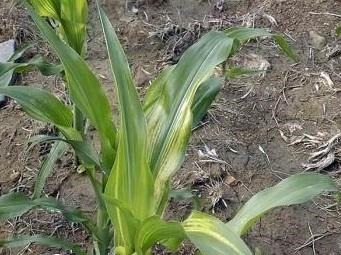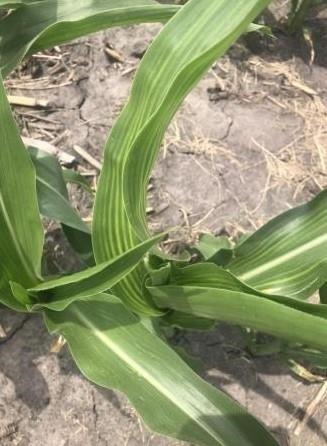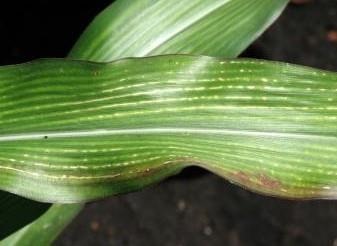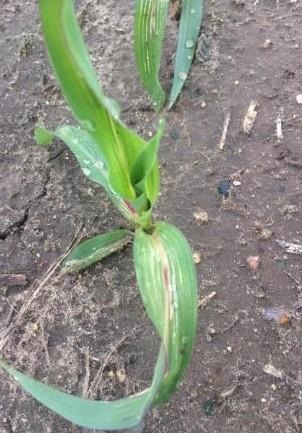 Photo 1. Genetic striping in corn. Photo credit: Alison Robertson, Iowa State University.
Photo 1. Genetic striping in corn. Photo credit: Alison Robertson, Iowa State University.
Nutrient Deficiencies
Zinc, sulfur, magnesium and manganese deficiencies can all lead to striping in corn, and with mild deficiency, it is often difficult to distinguish among them without soil and/or plant analysis and side by side comparisons. The following discussion is adapted from Extension publication IPM42, Nutrient Deficiencies and Application Injuries in Field Crops and other information is included in the nutrient topic section, Secondary and Micronutrients, of the Soil Fertility web site. Additional nutrient deficiency photos can be found in IPM42 and in the photo gallery of the Soil Fertility web page.
Zinc deficiency in corn is characterized by interveinal chlorosis and white bands that extend from the base of the leaf toward the tip. The leaf margins, midrib and leaf tip usually remain green (Photo 2). Plants will be stunted due to shortened internodes. Most plants will outgrow zinc deficiency. Zinc deficiency is not common in Iowa, but it can be found in soils that receive no manure, are calcareous (pH higher than 7.4), coarse textured, are very cool and wet, and with a very high phosphorus fertilizer application rate (around 200 lb P2O5/acre or higher) only with low or marginal zinc availability. ISU does provide micronutrient recommendations for zinc on corn and sorghum based on soil testing. See Table 15 of PM 1688, A General Guide for Crop Nutrient and Limestone Recommendations in Iowa.
 Photo 2. Zinc deficiency in corn. Photo Credit: John Sawyer, Iowa State University.
Photo 2. Zinc deficiency in corn. Photo Credit: John Sawyer, Iowa State University.
Sulfur deficiency is commonly seen in corn leaves during early and middle growth stages. Generally, the corn has a yellowish cast and interveinal chlorosis of the youngest leaves may occur because sulfur is not easily translocated in the plant. At early stages stripes sometimes do not develop and symptoms are confused with nitrogen deficiency. Plants may grow out sulfur deficiency as soil temperatures and moisture conditions improve, allowing for sulfur mineralization in the soil. Sulfur deficiency can occur on acid sandy, low organic matter and eroded soils as well as in cold and dry springs such as this year (Photo 3). Crop 3072, Sulfur Management for Iowa Crop Production, is a good reference for sulfur use in crops.
 Photo 3. Sulfur deficiency in corn. Photo Credit: Angie Rieck-Hinz, Iowa State University.
Photo 3. Sulfur deficiency in corn. Photo Credit: Angie Rieck-Hinz, Iowa State University.
Magnesium and manganese deficiencies in corn have not been well documented in Iowa. Deficiencies are commonly seen in states with soils having much higher calcium or potassium levels than in Iowa, with acidic, coarse-textured soils, and for manganese also in organic (muck and peat) soils. Striping by magnesium and manganese often show similar deficiency symptoms, which are generally characterized by yellow to white interveinal chlorosis. An important distinction is that since magnesium is highly mobile in the plant, symptoms show mainly in older leaves (Photo 4). However, manganese is immobile so symptoms tend to show in young and upper leaves. With extreme deficiency of magnesium older leaves may appear “beaded” due to round dead spots and may become reddish-purple with necrotic leaf tips and margins.
 Photo 4. Magnesium deficiency in corn. Photo credit: Jim Camberato, Purdue University.
Photo 4. Magnesium deficiency in corn. Photo credit: Jim Camberato, Purdue University.
Boron deficiency in corn has not been verified in Iowa. We include this note because there have been many phone calls this spring pointing at boron deficiency as a cause of striping in corn. Boron deficiency is characterized by brittle leaves, small dead spots in leaves that sometimes merge into stripes, and upper stalk internodes that do not elongate normally. In other states, boron deficiency is found in dry soils, sandy soils low in organic matter and calcareous high-pH soils.
Herbicide damage
We often see herbicide carryover issues in dry years that can impact corn and cause striping. Late applications of fomesafen can cause veinal chlorosis (actually whitening of the veins) not interveinal chlorosis as mentioned above, plus the midrib will exhibit a pinkish-red color. The leaves may become floppy due to loss of integrity of the midrib. Plants can recover from this injury, but at times there can be stand loss depending on the severity of the carryover. See Photo 5. A good discussion of factors that lead to this type of injury can be found in a recent ICM article, Fomesafen Carryover to Corn, by Meaghan Anderson.
 Photo 5. Fomesafen carryover injury to corn. Photo Credit: Angie Rieck-Hinz, Iowa State University.
Photo 5. Fomesafen carryover injury to corn. Photo Credit: Angie Rieck-Hinz, Iowa State University.
Summary
When crop foliage shows abnormal symptoms, often it is difficult to distinguish the cause with certainty because deficiency (or toxicity) of several nutrients, diseases, or herbicide damage sometimes produce similar effects. Nutrient deficiency or toxicity may be identified by sampling and testing soil and plant tissue (ideally both) from normal and abnormal field areas and comparing test results. There will always be some degree of uncertainty, however, because for some nutrients there are no reliable calibrations to interpret the test results.
Source : iastate.edu